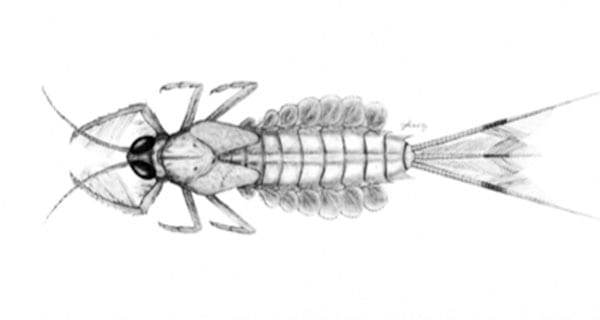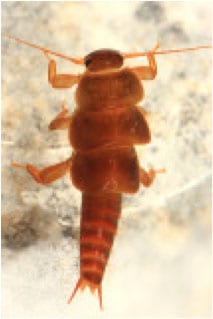By Dave Penrose

It’s a no-brainer; clean rivers and lakes support healthy fish populations. Prior to 1972 however, this wasn’t the case in many areas of our country. Rivers were extremely polluted and when the Cayahoga River in Cleveland caught on fire in 1969, people became worried and incensed at the same time. Congress acted to protect our waters by ratifying the Clean Water Act. For the first time in our history, the Environmental Protection Agency and State governments had the legal authority to regulate sources of water pollution. Biological monitoring of our rivers also became mandatory. One very important tool that water quality managers use to monitor the health of our rivers is the ecology of aquatic insects.
In addition to being important in the diets of most fish species, aquatic insects are effective tools for assessing stream health. The mayflies (Ephemeroptera), stoneflies (Plecoptera) and caddisflies (Trichptera) are among the most sensitive to pollution and are most often used by water quality managers as indicator taxa. There are approximately 300 species of mayflies in the southeastern United States (Morse, et. al., 2017) and they have exceptionally diverse habitat and feeding preferences. Mayflies live as nymphs within streams and lakes for most of their life cycles and as winged adults for only a day or two. The root word for the order of mayflies is “Ephemeros” and refers to the short life of the adult mayfly. In fact, mayflies lose their feeding mouthparts as they emerge from the water and focus only on reproduction and dropping eggs. Mayflies are important for anglers, and aquatic ecologists to understand because they are extremely common in most trout streams, and the hatches are frenzied bursts of activity and signal target days for many fly-anglers.


There are many new threats to our nation’s waterbodies. The unregulated discharge of pharmaceuticals and personal care products is a rising concern, as is the use of neonicotinoid insecticides. However, the appreciation of clean water is more alive today than ever. There are over 1700 citizen monitoring groups in the United States, many of them using aquatic insects as indicators, who are also passionate about clean streams. School children are becoming involved in water conservation issues as well. One impressive program is the Leaf Pack Network (https://leafpacknetwork.org/), which has been adopted by over 450 schools in 39 states and 12 countries. The use of aquatic insects as indicators of stream health is much more than just fish food.
Other Sources of Information
Society for Freshwater Science – www.freshwater-science.org
Freshwaters Illustrated – http://freshwatersillustrated.org
Trout Nut – http://www.troutnut.com/
Dave Penrose is a Retired Professor of NC State and a Water Quality Expert with Penrose Consulting, LLC. He consults frequently with RiverLink on Water Quality Improvement Projects
Morse, J.C., W.P. McCafferty, B.P. Stark & L.M. Jacobus, Editors. 2017. Larvae of the Southeastern USA Mayfly, Stonefly and Caddisfly Species. Biota of South Carolina. Vol 9, Clemson University Public Service Publishing Clemson University, Clemson, South Carolina, USA. 482 pp.
Morse, J.C. 2009. Chapter 8. Biodiversity of aquatic insects. In: Foottit, R.G., & P.H. Adler (Eds.), Insect Biodiversity: Science and Society. Wiley-Blackwell, Oxford, United Kingdom, pp. 165-184.